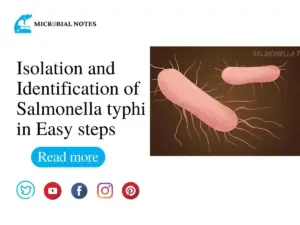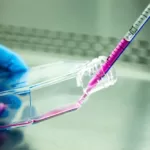Introduction
The Kirby Bauer Method also referred to as the disc diffusion method is a commonly used technique in microbiology for testing the susceptibility of bacteria to various antimicrobial agents. it involves the use of paper discs that are impregnated with different antibiotics or other antimicrobial agents.
Importance of the disc diffusion method
Antimicrobial resistance is an increasing global health problem, and the Kirby Bauer Disc Diffusion Method is an essential tool in the fight against this issue. This method allows for the rapid and accurate determination of the susceptibility of microorganisms to different antimicrobial agents. The results obtained from this technique are critical in guiding appropriate antibiotic therapy and ensuring effective treatment of bacterial infections. Furthermore, the Kirby Bauer Disc Diffusion Method is also useful in quality control and product development in the food and pharmaceutical industries.
History of the Kirby Bauer Disc Diffusion Method:
The Kirby Bauer Disc Diffusion Method was first described in 1966 by two researchers, Mary Kirby, and Alfred Bauer. However, the concept of using paper discs impregnated with antimicrobial agents for testing bacterial susceptibility dates back to the early 1940s. Over the years, the technique has been modified and refined to improve its accuracy and efficiency. Today, the Kirby Bauer Disc Diffusion Method remains one of the most widely used methods for antimicrobial susceptibility testing. The contributions of Kirby and Bauer to the development of this technique have been crucial in establishing its importance in microbiology.
Principles of the Kirby Bauer Disc Diffusion Method
The Kirby Bauer Disc Diffusion Method is a simple and effective technique for determining the susceptibility of microorganisms to antimicrobial agents. The basic principle of the technique involves the diffusion of antimicrobial agents from a paper disc into an agar medium that has been inoculated with the test microorganism. The antimicrobial agents diffuse outwards from the disc, creating a concentration gradient that inhibits the growth of the microorganism in its vicinity. The zone of inhibition that surrounds the disc is a measure of the susceptibility of the microorganism to the antimicrobial agent.
Factors affecting the diffusion of antimicrobial agents:
Several factors can affect the diffusion of antimicrobial agents in the Kirby Bauer Disc Diffusion Method. The size of the disc, the type of agar medium, the concentration of the antimicrobial agent, and the pH of the medium can all affect the diffusion of the agent. Larger discs and higher concentrations of the antimicrobial agent can lead to larger zones of inhibition, while acidic or alkaline pH can affect the solubility of the agent and its diffusion through the agar.
Factors affecting the growth of microorganisms:
The growth of microorganisms in the Kirby Bauer Disc Diffusion Method can also be affected by several factors. The type and age of the microorganism, the density of the inoculum, and the composition of the agar medium can all affect the growth of the microorganism. The inoculum should be standardized to ensure consistent results, and the agar medium should provide optimal growth conditions for the test microorganism. Additionally, the presence of other substances in the agar, such as blood or serum, can also affect the growth of the microorganism and the diffusion of the antimicrobial agent.
Materials and Equipment Required:
The following is a list of all necessary materials and equipment required for the Kirby Bauer Disc Diffusion Method:
- Antimicrobial agents: paper discs impregnated with antimicrobial agents (e.g., antibiotics, antifungals)
- Agar plates: solid nutrient media containing necessary nutrients for the growth of microorganisms
- Test microorganisms: pure cultures of the microorganisms to be tested
- Sterile swabs: for transferring the test microorganisms to the agar plates
- Inoculating loop or needle: for transferring the test microorganisms to the agar plates
- Incubator: for maintaining the appropriate temperature and conditions for bacterial growth
- Ruler or calipers: for measuring the diameter of the zones of inhibition
- Mueller Hinton agar: a commonly used agar medium for the Kirby Bauer Disc Diffusion Method
Alternatives and Substitutes for certain items
There are several alternatives and substitutes for certain items used in the Kirby Bauer Disc Diffusion Method. For example, instead of using paper discs impregnated with antimicrobial agents, other methods such as E-test strips or gradient diffusion methods can be used. Instead of Mueller Hinton agar, other types of agar media can be used depending on the test microorganism. However, it is important to note that using different materials and equipment may affect the accuracy and reliability of the results obtained from the Kirby Bauer Disc Diffusion Method.
Types of media and culture required
The type of media and culture required for the Kirby Bauer Disc Diffusion Method depends on the microorganisms being tested. Generally, Mueller Hinton agar is commonly used for testing bacteria, while Sabouraud agar is used for testing fungi.
Methods of preparation
Mueller Hinton agar preparation for antibiotic susceptibility test
- Weigh out the appropriate amount of Mueller Hinton agar powder and add it to distilled water.
- Heat the mixture until the agar is completely dissolved.
- Autoclave the solution to sterilize it.
- Cool the solution to around 50°C and pour it into sterile Petri dishes.
- Allow the agar to solidify before use.
Sabouraud agar preparation for antifungal susceptibility test
- Weigh out the appropriate amount of Sabouraud agar powder and add it to distilled water.
- Heat the mixture until the agar is completely dissolved.
- Autoclave the solution to sterilize it.
- Cool the solution to around 50°C and pour it into sterile Petri dishes.
- Allow the agar to solidify before use.
Sterilization techniques
- Sterilization is a critical step in preparing media and culture for the Kirby Bauer Disc Diffusion Method. The following techniques can be used for sterilization:
- Autoclaving: Autoclaving is the most commonly used method of sterilization. The media or culture is placed in a container and subjected to high-pressure steam at 121°C for 15 minutes.
- Dry heat sterilization: Dry heat sterilization involves heating the media or culture in a dry oven at 160-170°C for 2-3 hours.
- Filtration: Filtration involves passing the media or culture through a membrane filter with a pore size small enough to remove microorganisms.
Quality control and troubleshooting
Quality control is important to ensure accurate and reliable results in the Kirby Bauer Disc Diffusion Method. The following measures can be taken to ensure quality control:
- Check the expiry date of the media and culture before use.
- Use standardized methods of media and culture preparation.
- Use positive and negative control strains to ensure the quality of the media and culture.
- Perform regular checks on the incubator temperature and conditions to ensure optimal bacterial growth.
Preparation of the inoculum
The inoculum for the Kirby Bauer Disc Diffusion Method is prepared by suspending the microorganisms in sterile saline or broth. The following steps can be followed:
- Using a sterile loop or needle, obtain a pure culture of the microorganism.
- Add a small amount of sterile saline or broth to the culture and mix well to form a homogenous suspension.
- Adjust the turbidity of the suspension to match the 0.5 McFarland standard, which corresponds to a bacterial density of approximately 1-2 x 10^8 CFU/ml.
- Use the suspension to inoculate the Mueller Hinton or Sabouraud agar plates.
Quality control and troubleshooting
Quality control is important to ensure accurate and reliable results in the Kirby Bauer Disc Diffusion Method. The following measures can be taken to ensure quality control:
- Use standardized methods of inoculum preparation.
- Use positive and negative control strains to ensure the quality of the inoculum.
- Perform regular checks on the incubator temperature and conditions to ensure optimal bacterial growth.
Step-by-step guide to performing Kirby Bauer Disc Diffusion Method
- Prepare the Mueller Hinton or Sabouraud agar plates according to the manufacturer’s instructions.
- Prepare the inoculum as described above and apply it to the agar plates using a sterile swab or loop.
- Allow the plates to dry for 5-10 minutes.
- Place the antimicrobial discs on the agar plates using sterile forceps, ensuring they are evenly spaced.
- Gently press down on the discs to ensure good contact with the agar surface.
- Incubate the plates at the appropriate temperature and conditions for the microorganisms being tested.
- After incubation, measure the zones of inhibition around the discs using a ruler or caliper.
- Record the zone sizes and interpret the results using established guidelines or interpretive criteria.

Tips for accurate and consistent results
- Use standardized methods and materials for the preparation of the inoculum and media.
- Ensure the antimicrobial discs are not expired and are stored properly.
- Ensure that the inoculum is evenly spread on the agar surface and the discs are pressed firmly onto the surface.
- Incubate the plates at the appropriate temperature and conditions for the microorganisms being tested.
- Measure the zone sizes accurately using a ruler or caliper.
- Interpret the results according to established guidelines or interpretive criteria.
Common errors and troubleshooting
- Uneven or inadequate inoculation of the agar plates can lead to inaccurate or inconsistent results. Ensure that the inoculum is spread evenly and adequately on the agar surface.
- Improper storage or handling of antimicrobial discs can lead to loss of potency or contamination. Ensure that the discs are stored properly and used within the expiration date.
- Inaccurate measurement of the zone sizes can lead to incorrect interpretation of the results. Use a ruler or caliper to measure the zone sizes accurately.
- Improper incubation temperature or conditions can affect the growth of microorganisms and lead to inaccurate or inconsistent results. Ensure that the plates are incubated at the appropriate temperature and conditions for the microorganisms being tested.
- Contamination of the media or inoculum can lead to inaccurate or inconsistent results. Use sterile techniques and perform regular quality control checks to ensure the accuracy and reliability of the results.
Methods of measuring and recording the zones of inhibition
The zone of inhibition around each antimicrobial disc is measured using a ruler or caliper. The diameter of the zone is recorded in millimeters and compared to the established interpretive criteria.
Interpretation of Results
The interpretation of the results is based on established guidelines such as CLSI guidelines criteria that are specific to each antimicrobial agent and microorganism. These criteria are determined based on the minimum inhibitory concentration (MIC) of the antimicrobial agent required to inhibit the growth of the microorganism.
For result interpretation click here to get the CLSI guidelines
The zone of inhibition around the antimicrobial disc is measured and compared to established interpretive criteria to determine the susceptibility or resistance of the microorganism. The size of the zone of inhibition is influenced by the potency of the antimicrobial agent, the diffusion rate of the agent, and the sensitivity of the microorganism to the agent.
Determining the susceptibility or resistance of microorganisms:
Based on the diameter of the zone of inhibition, the susceptibility or resistance of the microorganism can be determined. The interpretive criteria for each antimicrobial agent and microorganism are established by clinical and laboratory standards organizations and are based on extensive testing and research.
The microorganism is classified as susceptible, intermediate, or resistant based on the diameter of the zone of inhibition. Susceptible microorganisms are those that are inhibited by the antimicrobial agent at clinically achievable concentrations. Intermediate microorganisms are those that may respond to higher doses of the antimicrobial agent or when concentrations are high at the site of infection. Resistant microorganisms are those that are not inhibited by the antimicrobial agent at clinically achievable concentrations.
Applications of the Kirby Bauer Disc Diffusion Method
The Kirby Bauer Disc Diffusion Method is a widely used technique in microbiology and has various applications in clinical, industrial, and research settings.
Clinical applications in antibiotic susceptibility testing
The Kirby Bauer Disc Diffusion Method is commonly used in clinical microbiology laboratories to determine the susceptibility or resistance of bacteria to various antimicrobial agents. This technique is essential in guiding the selection of appropriate antibiotic therapy and preventing the spread of antimicrobial resistance.
The method is used to test a wide range of bacterial infections, including urinary tract infections, respiratory tract infections, and skin and soft tissue infections. The results of the test are reported to physicians, who use them to select the most effective antimicrobial agent for treatment.
Industrial applications in quality control and product development
The Kirby Bauer Disc Diffusion Method is used in the quality control of various industrial products, including food, cosmetics, and pharmaceuticals. In the food industry, the method is used to test the antimicrobial activity of preservatives and other food additives.
In the cosmetic industry, the method is used to test the efficacy of antimicrobial agents in personal care products. In the pharmaceutical industry, the method is used to test the antimicrobial activity of new drugs and to monitor the quality of existing drug products.
Research applications in antimicrobial resistance studies
The Kirby Bauer Disc Diffusion Method is used in research to study antimicrobial resistance in bacteria. The method is used to determine the minimum inhibitory concentration (MIC) of various antimicrobial agents required to inhibit the growth of bacteria.
Advantages and Limitations of the Kirby Bauer Disc Diffusion Method
The Kirby Bauer Disc Diffusion Method is a widely used technique in microbiology for determining the susceptibility or resistance of microorganisms to various antimicrobial agents. Like any other laboratory technique, it has its advantages and limitations.
Advantages of the Kirby Bauer Disc Diffusion Method
Simplicity: The technique is relatively simple and requires minimal equipment, making it cost-effective and accessible to most laboratories.
Rapid results: The results of the test can be obtained within 24-48 hours, allowing for prompt selection of appropriate antimicrobial therapy.
Cost-effective: The technique is cost-effective compared to other antimicrobial susceptibility testing methods, such as automated systems.
Large range of antimicrobial agents: The technique allows for testing a wide range of antimicrobial agents, making it useful for the screening of new drugs and the surveillance of antimicrobial resistance.
Limitations and challenges of the Kirby Bauer Disc Diffusion Method
Interpretation of results: The interpretation of results can be subjective, leading to potential errors and variability in the results.
Limited sensitivity and specificity: The method is not as sensitive or specific as other antimicrobial susceptibility testing methods, such as the broth microdilution method.
Quality control: The method requires strict quality control procedures to ensure accurate and reproducible results.
Organism variability: Variability in the growth of microorganisms can affect the size of the zone of inhibition, leading to potential errors in interpretation.
Comparison with other antimicrobial susceptibility testing methods:
Broth microdilution method: The broth microdilution method is a more sensitive and specific method for determining antimicrobial susceptibility, but it requires more equipment and is more time-consuming.
Automated systems: Automated systems are faster and more objective than the Kirby Bauer Disc Diffusion Method, but they are more expensive and may not be accessible to all laboratories.
E-test method: The E-test method is a more accurate and reproducible method than the Kirby Bauer Disc Diffusion Method, but it is also more expensive and requires specialized equipment.
References
- Willey, J. M., Sandman, K. M., Wood, D. H., & Prescott, L. M. (2019). Prescott’s microbiology (11th ed.). McGraw Hill.
- Cappuccino J.G. and Sherman N. 2008. Microbiology: A Laboratory Manual, 8th ed. Pearson Benjamin Cummings, San Francisco, CA, USA.
- Clinical Microbiology Procedures Handbook, Fourth Edition. (2016). In Clinical Microbiology Procedures Handbook, Fourth Edition. American Society of Microbiology. https://doi.org/10.1128/9781555818814
- Procop, G. W., Church, D. L., & Koneman, E. W. (2020). Koneman’s Color Atlas and Textbook of Diagnostic Microbiology. Jones & Bartlett Learning.
- https://medlineplus.gov/lab-tests/antibiotic-sensitivity-test/





